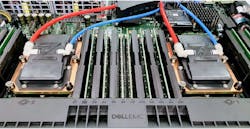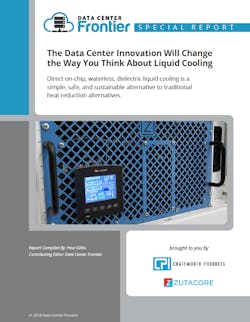The Advantages of Liquid Cooling
Last week we launched our article series on the latest innovations in liquid cooling technology. This week we'll explore the advantages of liquid cooling.
Many older facilities “are limited in their ability to supply the necessary airflow to cool high-density IT,” noted Uptime Institute Research Analyst Jacqueline Davis. “A growing number of data center operators will consider support for direct liquid cooling.”
Precision liquid cooling targets the heat at the source rather than at the room or row level creating, a more efficient, higher-capacity solution. The technology is on its way to becoming a standard for data centers running high-density server racks. The market for liquid-cooling IT equipment surpassed $2 billion in 2022 and is expected to grow 15% annually to $12 billion by 2032, according to Global Market Insights.
“To reduce power consumption and adhere to the ambitious emission standards and footprint goals set by different governments, data center operators worldwide are rapidly adopting energy-efficient and cost-effective liquid cooling technologies,” the research firm wrote.
“Newer and more efficient cooling technologies such as liquid cooling can have a higher initial investment cost but may provide long-term cost savings in terms of energy consumption and maintenance,” wrote research firm Astute Analytica in a recent report.
The advantages of liquid cooling
Liquid cooling has numerous benefits when compared to air-conditioning, starting with the fact that liquids conduct heat up to 1,000 times better than air. The raised floors and containment aisle that are common to most data centers aren’t necessary and equipment can be packed together more densely because airflow isn’t a concern. Liquid cooling also consumes far less power than air-conditioning, reducing energy consumption by up to 90%.
The benefits of liquid cooling go beyond power efficiency. CPUs and GPUs operate faster and more efficiently at lower temperatures because individual cores can run longer without hitting thermal thresholds that automatically throttle performance to reduce the risk of overheating. Overall efficiency is improved because processors can do more work per unit of energy.
Join us on Aug. 29th for a day of learning covering air-based cooling and direct-on-chip cooling technologies, and optimizing the data center cooling cycle. Register for the Data Center Frontier Cooling Educational Forum today.
As Uptime Institute research director Daniel Bizo summarized, “Performance is best served cold.”
Until recently, however, the use of liquid cooling has been principally confined to the largest scientific and academic computing environments. This is due to misconceptions about costs and reliability that are rooted in the comparatively primitive and expensive systems of years ago. Some data center managers may also believe liquid cooling is overkill, despite trends indicating that the size of the workloads they are processing will continue to grow.
It’s true that water cooling, which has long been the most common approach, does have some potential downsides. One is that large infrastructure investments may be required to outfit the data center with the necessary plumbing and chillers. Cooling equipment also takes up space that could otherwise be used for servers, storage, and other IT gear. There are also legitimate concerns that an unintended release of coolant into the data center could cause liquid to come into contact with sensitive electronic components, leading to short circuits, corrosion, or other forms of damage.
If a liquid cooling system isn’t installed correctly, it may not effectively distribute the coolant or maintain proper pressure, which can lead to uneven cooling, localized hotspots, and damage to undercooled components. Failures in the pumps and power supplies required to chill and distribute the cooling liquid can also result in inadequate cooling, overheating, or other issues that can potentially damage infrastructure.
While these risks were common in the cooling systems of years ago, modern liquid cooling systems are designed with numerous safety measures, redundancy, and monitoring systems to mitigate the chance of damage. Recent innovations have made the technology both safer and more affordable.
Download the full report, The Data Center Innovation Will Change the Way You Think About Liquid Cooling, featuring Chatsworth Products and Zutacore, to learn more. In our next article, we'll go beyond water and dive into dielectric fluid and direct-on-chip cooling.



